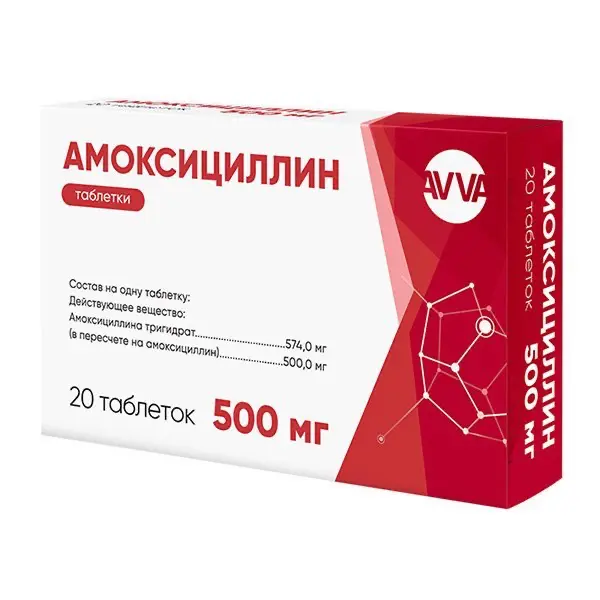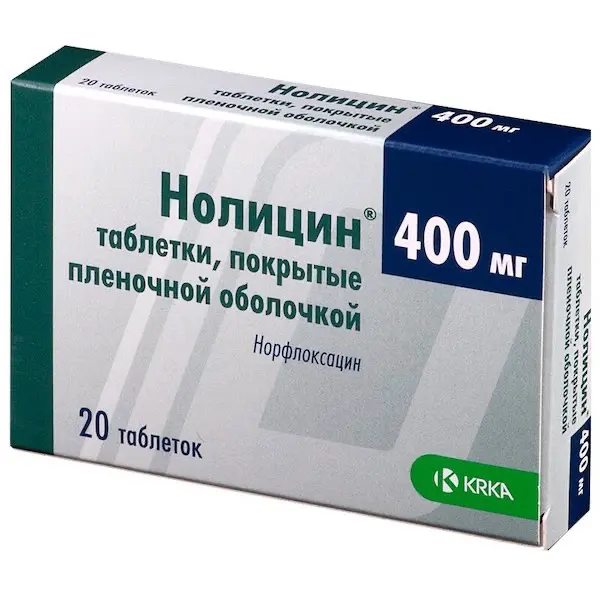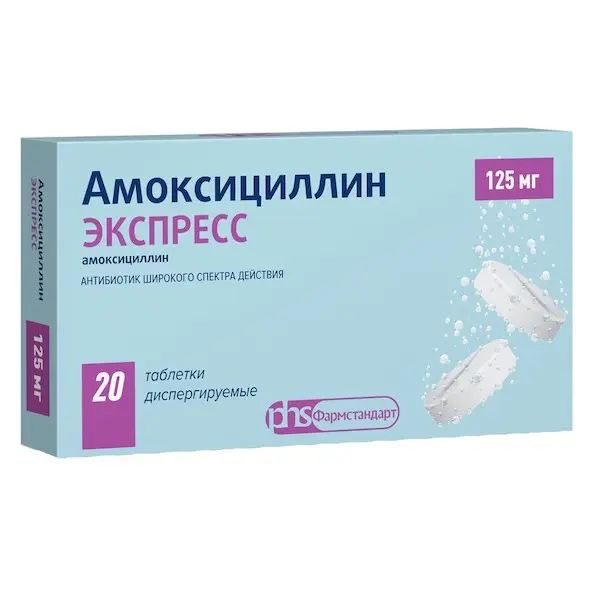Description
Amoxicillin Pharmacodynamics
Amoxicillin is an aminobenzyl penicillin, a broad-spectrum semi-synthetic antibiotic with bactericidal action as a result of inhibition of bacterial cell wall synthesis. Minimum inhibitory concentration (MIC) thresholds vary for different susceptible microorganisms. The prevalence of resistant strains varies geographically and at different times, so it is advisable to focus on local resistance information, especially when treating severe infections.
Boundary of resistance
MIC boundary values for amoxicillin according to the European Committee for the Study of Antimicrobial Susceptibility (EUCAST), version 5.0.
Pathogen Borderline MIC values (mg/L)
Sensitive < Resistant >
Enterobacteriaceae 81 8
Staphylococcus spp. see note see note2
Enterococcus spp.3 4 8
Streptococcus groups L, B, C, and G see note4 see note4
Streptococcus pneumoniae 5
see footnote 4 see footnote 5
Streptococcus viridans group 0.5 2
Haemophilus influenzae 26 26
Moraxella catarrhal is see note see note7
Neisseria meningitidis 0.125 1
Gram-positive anaerobes other than Clostridium difficile 4 8
Gram-negative anaerobes 0.5 2
Helicobacter pylori 0.1259 0.125h
Pasteurella multocida 1 1
Borderline values without definite type of bacteria10 2 8
1 The wild type of Enterobacteriaceae is classified as susceptible to aminopenicillin. In some countries, a separate classification of wild type strains of E.coli and P.mirabilis as intermediates is preferred. In this case, a borderline MIC value of S<0.5 mg/L should be used.
2 Most staphylococci are resistant to amoxicillin due to their ability to synthesize penicillinase. Methicillin-resistant strains, with some exceptions, are resistant to beta-lactam antibiotics.
3 Susceptibility to amoxicillin can be determined by ampicillin.
4 Penicillin susceptibility of group A, B, C, and G streptococci can be determined by benzylpenicillin.
5 Borderline values apply only to nonmeningitic strains. If strains are classified as ampicillin intermediates, oral treatment with amoxicillin should be avoided. Susceptibility is determined by the MIC value for ampicillin.
6 Borderline values refer to intravenous use. Beta-lactam-synthesizing strains should be considered resistant.
7 Beta-lactamase-synthesizing strains should be considered resistant.
8 Susceptibility to amoxicillin can be determined by benzylpenicillin.
9 Borderline values refer to epidemiologic cutoff points distinguishing between wild-type strains and strains with reduced susceptibility.
10 Borderline values without a specific bacterial species refer to a dosage of at least 0.5 g 3-4 times daily (1.5 to 2 g/day).
Sensitivity of microorganisms to amoxicillin in the laboratory
Common susceptible pathogens
Aerobic gram-positive microorganisms:
Enterococcus faecal is.
Beta-haemolytic streptococci (groups A, B, C, and G)
Listeria monocytogenes
Types of bacteria in which acquired resistance is possible
Aerobic Gram-negative microorganisms:
Escherichia coli
Haemophilus influenzae
Helicobacter pylori
Proteus mirabilis
Salmonella typhi
Salmonella paratyphi
Shigella spp.
Pasteurella multocida
Aerobic Gram-positive microorganisms:
Coagulazonegative staphylococci
Staphylococcus aureus1
Streptococcus pneumoniae
Streptococcus viridans group
Anaerobic Gram-positive microorganisms:
Clostridium spp.
Anaerobic Gram-negative microorganisms:
Fusobacterium spp.
Other microorganisms:
Vogelia burgdorferi.
Naturally resistant organisms2
Aerobic Gram-positive microorganisms:
Enterococcus faecium1
Aerobic Gram-negative microorganisms:
Acinetobacter spp.
Enterobacter spp.
Klebsiella spp.
Pseudomonas spp.
Anaerobic Gram-negative microorganisms:
Bacteroides spp. (some strains of Bacteroides fragilis are resistant)
Other microorganisms
Chlamydia spp.
Mycoplazma spp.
Legionella spp.
1 Natural medium sensitivity in the absence of acquired resistance mechanisms.
2 Almost all strains of S. aureus are resistant to amoxicillin because they produce penicillinase.
Bacteria may have resistance to amoxicillin as a result of production of beta-lactamases that hydrolyze aminopenicillins (which can be inhibited by clavulanic acid), changes in penicillin-binding proteins, permeability to the drug, or the efflux pump mechanism. Several resistance mechanisms may be present simultaneously in a single microorganism, which explains the existence of variable and unpredictable cross-resistance to other beta-lactams and antibacterials from other groups.
Indications
Infectious-inflammatory diseases caused by microorganisms sensitive to the drug:
– Upper respiratory tract infections (tonsillopharyngitis, sinusitis, acute otitis media);
– lower respiratory tract infections (acute bacterial bronchitis, exacerbation of chronic bronchitis, community-acquired pneumonia);
– Infections of the urogenital system (pyelonephritis, pyelitis, cystitis, urethritis, endometritis, cervicitis, gonorrhea);
– Abdominal infections (cholangitis, cholecystitis);
– eradication of Helicobacter pylori in patients with duodenal ulcer or stomach ulcer (always in combination with other drugs);
– skin and soft tissue infections (rye, impetigo, secondary infected dermatoses);
– leptospirosis, listeriosis;
– Lyme disease;
– gastrointestinal tract infections (enterocolitis, typhoid, dysentery, salmonellosis (caused by Salmonella typhi, sensitive to ampicillin), salmonellosis;
– Prophylaxis of bacterial endocarditis during surgical procedures in the oral cavity and upper respiratory tract
Contraindications
– Hypersensitivity to amoxicillin, other beta-lactam antibiotics (other penicillins, cephalosporins, monobactams, carbapenems) or any components of the drug;
– infectious mononucleosis, lympholeukemia;
– children under 3 years of age (for this dosage form).
Caution
Allergic reactions (including bronchial asthma, pollinosis, hypersensitivity to acetylsalicylic acid) in the anamnesis, gastro-intestinal diseases in the anamnesis (especially colitis, associated with antibiotic use), renal failure, pregnancy and lactation.
Administration during pregnancy and breastfeeding
Results from animal studies indicate no direct or indirect effects on reproductive toxicity. Limited data on the use of amoxicillin during pregnancy in humans indicate no increased risk of congenital malformations. Amoxicillin can be used during pregnancy only in cases when the expected benefit to the mother exceeds the potential risk to the fetus.
Amoxicillin is excreted into breast milk in small amounts, if necessary, the drug can be used during breastfeeding. A child who is breastfed may develop diarrhea, sensitization and fungal infection of the mucous membranes, so it may be necessary to stop breastfeeding. Amoxicillin should be used during breastfeeding only after evaluation by the attending physician of the benefit/risk ratio.
Dosage and administration
- Orally, before or after meals.
The dosage of Amoxicillin depends on the sensitivity of the infectious agent, the severity of the disease and localization of the infection. - Adults and children over 13 years of age and / or body weight over 40 kg Usually prescribed 250 mg – 500 mg 3 times a day or 500 mg – 1000 mg 2 times a day. In sinusitis, community-acquired pneumonia and other severe infections, 500 mg to 1000 mg 3 times daily is recommended. Maximum daily dose is 6 g.
- Children from 3 to 5 years of age and/or body weight from 15 kg and up to 19 kg
Usually 250 mg 2 times a day is prescribed. In cases where there is a high probability of infection caused by resistant Streptococcus pneumoniae, higher doses of 500 mg 2-3 times daily are recommended. - Children from 5 to 13 years of age and/or with a body weight between 19 kg and 40 kg Usually 250 mg 3 times a day is recommended. In cases where there is a high probability of infection caused by resistant Streptococcus pneumoniae, higher doses of 500-1000 mg 3 times daily are recommended.
- The maximum daily dose for children is 100 mg/kg/day.
Lyme Disease (Borreliosis) – Early Stage
Adults and children over 13 years of age and/or over 40 kg body weight
500 mg – 1000 mg 3 times daily up to a maximum daily dose of 4 g divided into several doses over 14 days (10-21 days). - Children from 3 to 5 years of age and/or body weight from 15 kg to 19 kg 250 mg 3 times a day.
- Children from 5 to 13 years of age and/or with body weight between 19 and 40 kg
500 mg 2-3 times per day (at the rate of 50 mg/kg/day, divided into 3 doses).
Eradication of Helicobacter pylori in patients with duodenal ulcer or stomach ulcer (always in combination with other drugs)
Adults 1000 mg 2 times daily in combination with a proton pump inhibitor (e.g., omeprazole, lansoprazole) and another antibiotic (e.g., clarithromine, metronidazole) for 7 days. - Children over 13 years of age and/or with body weight over 40 kg – 1000 mg 2 times as part of combined therapy.
Children from 3 to 5 years of age and/or body weight from 15 to 19 kg 250-500 mg 2 times a day. - Children 5 to 13 years of age and/or with body weight between 19 and 40 kg
500-1000 mg twice a day (at the rate of 50 mg/kg/day, divided into 2 doses).
Prophylaxis of bacterial endocarditis - Adults and children over 13 years of age and/or with body weight over 40 kg
Recommended 2 g (or at the rate of 50 mg/kg/day) 0.5-1 hour before surgery.
Children 3 to 5 years of age and/or body weight 15 to 19 kg 750-1000 mg (or at the rate of 50 mg/kg/day) before the procedure.
Children from 5 to 13 years of age and/or with body weight of 19 kg and up to 40 kg 1000-2000 mg (at the rate of 50 mg/kg/day) before the procedure.
In renal failure. - No dose adjustment is necessary in patients with a CKR >30 mL/min. In patients with CKD < 30 ml/min, it is recommended to increase the interval between doses or to reduce subsequent doses.
Dosing regimen of Amoxicillin in adults and children with body weight of 40 kg or more Dosing regimen of Amoxicillin in children with body weight less than 40 kg
10-30 ml/min maximal dose 500 mg 2 times a day Standard dose 2 times a day (corresponding to 2/3 of the dose)
< 10 ml/min maximal daily dose 500 mg once daily (corresponding to 1/3rd of the dose) - Patients on hemodialysis
Amoxicillin may be removed from the circulation by hemodialysis.
Hemodialysis
Adults and children with a body weight greater than 40 kg 500 mg every 24 hours
An additional dose of 500 mg should be administered before the hemodialysis procedure. In order to restore circulating drug concentrations, it is necessary after
hemodialysis procedure should also be administered 500 mg after the end of the hemodialysis procedure.
Children with a body weight of 15 mg/kg/day once daily
less than 40 kg An additional dose of 15 mg/kg body weight should be administered before the hemodialysis procedure. To restore the level of circulating drug concentration, a dose of 15 mg/kg of body weight should also be administered after the hemodialysis procedure. - Patients on peritoneal dialysis
Maximum dose of amoxicillin 500 mg/day.





